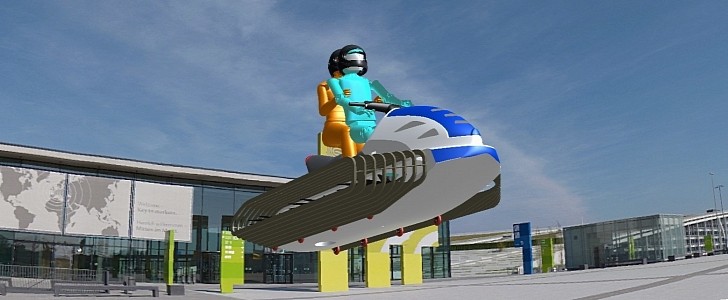We’re witnessing a golden age for urban mobility startups, from two-wheeler manufacturers to eVTOL (electric vertical take-off and landing) developers. So, why not combine them? A mobility startup is gearing up to launch a hybrid-electric hoverbike, using another young company’s game-changing propulsion technology.
Thomas (TJ) Wright, former NFL player, founded Horizon Aeronautics together with a team of experienced engineers and designers. Their first goal? To launch a short-distance commuter vehicle that looks like a jet ski and is powered by a hybrid-electric system. But the nine-foot-long (2.7 meters) and four-foot-wide (1.2 meters) hoverbike came with its challenges since it’s supposed to be a very-low flying vehicle.
This is why they teamed up with Blainjett Aviation, a propulsion technology expert that developed an innovative solution called the Dynamic Variable Pitch (DVP). This technology allows rotorcraft to generate higher speeds, while skipping the large rotating assemblies typically used for helicopters or eVTOLs. Since the Horizon hoverbike needs room for passengers, a solution that would eliminate heavy rotors sounded great.
The Blainjett team started working on various rotor configurations that could be integrated with an electric powertrain and came up with an innovative solution that maximizes space, while still generating high speeds. Instead of an eVTOL-like design with each rotor exposed, half of each multi-blade rotor is hidden in the hoverbike’s body. Based on their DVP technology, this unusual hemispherical lift-rotor configuration allows lift and vectored thrust to be generated by just one half of the rotor.
"It turned out when we compared our thrust output and efficiency to ducted fans and smaller rotors we were 2-3 times more efficient with 2-3 times more power density while fitting in the same available space. There's also a reduction in aerodynamic drag in forward flight,” explained Blainjett president, Cary Zachary.
TJ Wright’s startup is planning to launch the hoverbike prototype integrating this unique hemispherical rotor design by the end of this year. Meanwhile, Blainjett will continue testing its solution for multiple applications.
This is why they teamed up with Blainjett Aviation, a propulsion technology expert that developed an innovative solution called the Dynamic Variable Pitch (DVP). This technology allows rotorcraft to generate higher speeds, while skipping the large rotating assemblies typically used for helicopters or eVTOLs. Since the Horizon hoverbike needs room for passengers, a solution that would eliminate heavy rotors sounded great.
The Blainjett team started working on various rotor configurations that could be integrated with an electric powertrain and came up with an innovative solution that maximizes space, while still generating high speeds. Instead of an eVTOL-like design with each rotor exposed, half of each multi-blade rotor is hidden in the hoverbike’s body. Based on their DVP technology, this unusual hemispherical lift-rotor configuration allows lift and vectored thrust to be generated by just one half of the rotor.
"It turned out when we compared our thrust output and efficiency to ducted fans and smaller rotors we were 2-3 times more efficient with 2-3 times more power density while fitting in the same available space. There's also a reduction in aerodynamic drag in forward flight,” explained Blainjett president, Cary Zachary.
TJ Wright’s startup is planning to launch the hoverbike prototype integrating this unique hemispherical rotor design by the end of this year. Meanwhile, Blainjett will continue testing its solution for multiple applications.






